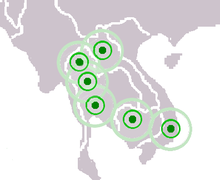- Mandala (Southeast Asian history)
-
Mandala (मण्डल) is a Sanskrit word that means "circle". The mandala is a model for describing the patterns of diffuse political power in early Southeast Asian history when local power was more important. The concept of a mandala counteracts modern tendencies to look for unified political power, i.e., the power of large kingdoms and nation states of later history, an inadvertent byproduct of 15th-century advances in map-making technologies.[1] In the words of O. W. Wolters who originated the idea in 1982:
"The map of earlier Southeast Asia which evolved from the prehistoric networks of small settlements and reveals itself in historical records was a patchwork of often overlapping mandalas"[2]
In some ways similar to the feudal system of Europe, states were linked in overlord-tributary relationships. Compared to feudalism however, the system gave greater independence to the subordinate states; it emphasised personal rather than official or territorial relationships; and it was often non-exclusive. Any particular area, therefore, could be subject to several powers or none.
Contents
Terminology
The term draws a comparison with the mandala of the Hindu and Buddhist worldview; the comparison emphasises the radiation of power from each power center, as well as the non-physical basis of the system.
Other metaphors such as Tambiah's original idea of a "galactic polity",[3] describe similar political patterns as the mandala. The metaphor of a "solar polity" is preferred by the historian Victor Lieberman[4], because in the solar system there is one central body, the sun, and the components or planets of the solar system galaxies.[5]
History
Historically, the main overlord states were Khmer Empire of Cambodia, Srivijaya Empire of Sumatra, successive kingdoms of Java (Mataram, Kediri, Singhasari and Majapahit), Ayutthaya in Thailand, Vietnam and China.[6] China occupies a special place in that the other three often in turn paid tribute to China, although in practice the obligations imposed on them were minimal. The most notable tributary states were Cambodia, Lan Xang (succeeded by Vientiane and Luang Prabang) and Lanna. Cambodia in particular, was described by the Vietnamese emperor Gia Long as "an independent country that is slave of two" (Chandler p. 119). The system was eventually ended by the arrival of the Europeans in the mid-19th century. Culturally, they introduced Western geographical practices, which assumed that every area was subject to one sovereign. Practically, the colonisation of French Indochina, and British Malaya and Burma brought pressure from the colonisers for fixed boundaries to their possessions. The tributary states were then divided between the colonies and Siam, which exercised much more centralised power, but over a smaller area, than hitherto.
The historian Stuart-Fox uses the term "mandala" extensively to describe the history of the Lao kingdom of Lan Xang as a structure of loosely held together "meuang" that disintegrated after Lan Xang's conquest by Siam starting in the 18th century[7]
The Thai historian Sunait Chutintaranond made an important contribution to study of the mandala in Southeast Asian history by demonstrating that "three assumptions responsible for the view that Ayudhya was a strong centralized state" did not hold and that "in Ayudhya the hegemony of provincial governors was never successfully eliminated"[8]
Obligations
The obligations on each side of the relationship varied according to the strength of the relationship and the circumstances. In general, the tributary was obliged to pay bunga mas, a regular tribute of various valuable goods and slaves, and miniature trees of gold and silver (bunga mas dan perak). The overlord ruler reciprocated with presents often of greater value than those supplied by the tributary. However, the tributary also had to provide men and supplies when called on, most often in time of war. The main benefit to the tributary was protection from invasion by other powers, although as Thongchai notes (p. 88), this was often "mafia-like protection" from the threats of the overlord himself. In some cases, the overlord also controlled the succession in the tributary, but in general interference with the tributary's domestic affairs was minimal: he would retain his own army and powers of taxation, for example. In the case of the more tenuous relationships, the "overlord" might regard it as one of tribute, while the "tributary" might consider the exchange of gifts to be purely commercial or as an expression of goodwill (Thongchai p. 87).
Personal relationships
The emphasis on personal relationships was one of the defining characteristics of the mandala system. The tributary ruler was subordinate to the overlord ruler, rather than to the overlord state in the abstract. This implied many important reasons. A strong ruler could attract new tributaries, and would have strong relationships over his existing tributaries. A weaker ruler would find it harder to attract and maintain these relationships. This was put forward as one cause of the sudden rise of Sukhothai under Ramkhamhaeng, for example, and for its almost equally steep decline after his death (Wyatt, 45 and 48). The tributary ruler could repudiate the relationship and seek either a different overlord or complete independence. The system was non-territorial. The overlord was owed allegiance by the tributary ruler, or at most by the tributary's main town, but not by all the people of a particular area. The tributary owner in turn had power either over tributary states further down the scale, or directly over "his" people, wherever they lived. No ruler had authority over unpopulated areas.
Non-exclusivity
The overlord-tributary relationship was not necessarily exclusive. A state in border areas might pay tribute to two or three stronger powers. The tributary ruler could then play the stronger powers off against each other in order to minimise interference by either one, while for the major powers the tributaries served as a buffer zone to prevent direct conflict between them.
Notes
- ^ "How Maps Made the World". Wilson Quarterly. Summer 2011. http://www.wilsonquarterly.com/article.cfm?AID=1992. Retrieved 28 July 2011. "Source: 'Mapping the Sovereign State: Technology, Authority, and Systemic Change' by Jordan Branch, in International Organization, Winter 2011."
- ^ O.W. Wolters, 1999, p. 27
- ^ Tambiah, Stanley Jeyaraja. World Conqueror and World Renouncer : A Study of Buddhism and Polity in Thailand against a Historical Background. Cambridge: Cambridge University Press, 1976. ISBN 0-521-29290-5. Chapter 7, cited in Lieberman, Strange Parallels: Southeast Asia in Global Context c. 800-1830. Cambridge: Cambridge University Press, 2003-2009 ISBN: 9786610160440. P. 33
- ^ "Victor B. Lieberman" (Biography). Professor of History, Department of History, appointed 1984. University of Michigan. February 4, 2005. http://www.umich-cseas.org/faculty/biographies/lieberman.htm. Retrieved August 17, 2011. "Center for Southeast Asian Studies"
- ^ Lieberman, 2003, p. 33
- ^ O.W. Wolters, 1999, pp. 27-40, 126-154
- ^ Martin-Fox, 1998, pp. 14-15
- ^ O.W. Wolters, pp. 142-143 citing Chutintaranond, 1990, pp. 97-98
Additional references
- Chandler, David. A History of Cambodia. Westview Press, 1983. ISBN 0-8133-3511-6
- Chutintaranond, Sunait, "Mandala, segmentary state, and Politics of Centralization in Medieval Ayudhya," Journal of the Siam Society 78, 1, 1990, p. 1.
- Lieberman, Victor, Strange Parallels: Southeast Asia in Global Context, c. 800-1830, Volume 1: Integration on the Mainland, Cambridge University Press, 2003.
- Stuart-Fox, Martin, The Lao Kingdom of Lan Xang: Rise and Decline, White Lotus, 1998.
- Tambiah, S. J., World Conqueror and World Renouncer, Cambridge, 1976.
- Thongchai Winichakul. Siam Mapped. University of Hawaii Press, 1984. ISBN 0-8248-1974-8
- Wolters, O.W. History, Culture and Region in Southeast Asian Perspectives. Institute of Southeast Asian Studies, 1982. ISBN 0-87727-725-7
- Wolters, O.W. History, Culture and Region in Southeast Asian Perspectives. Institute of Southeast Asian Studies, Revised Edition, 1999.
- Wyatt, David. Thailand: A Short History (2nd edition). Yale University Press, 2003. ISBN 0-300-08475-7
Additional reading
- Political reasons for survey and map making in Siam detailed in Twentieth century impressions of Siam its history, people, commerce, industries, and resources, with which is incorporated an abridged edition of Twentieth century impressions of British Malaya. Editor in chief: Arnold Wright ... Assistant editor: Oliver T. Breakspear ... Published 1908 by Lloyds Greater Britain Publishing Company, Ltd. in London [etc.] Library of Congress classification: DS565.W7 Open Library
See also
- Monthon - Siamese system of local administration from 1897 to 1933, based loosely on the same principle
- Mount Meru - considered to be the center of all the physical, metaphysical and spiritual universes
- Sumeru - the central world-mountain in Buddhist cosmology
- Thai royal and noble titles
- Trifunctional hypothesis
- Zomia (geography)
Categories:- Feudalism
- History of Southeast Asia
- Tai history
Wikimedia Foundation. 2010.


